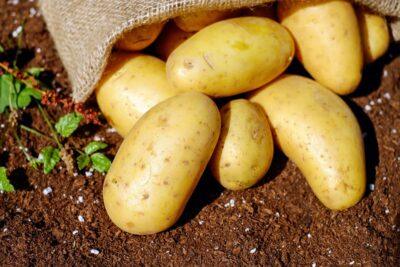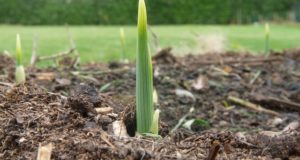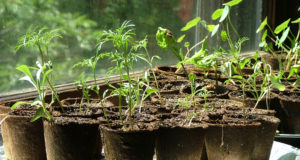We don’t always have to look that far to find interesting stuff. In fact, sometimes it turns out that it’s been right there in our everyday lives all along. To wit: the humble potato

Here are eight facts about potatoes—some are well-known, and others less familiar.
1. Potatoes have been said to provide almost complete nutrition. I have no plans to try living on potatoes alone and certainly do not recommend it for anyone else. But it has been done. People throughout history have thrived for long periods of time on a diet of mostly potatoes, or potatoes and milk, and the potato is still considered a staple in many cultures. Potatoes can comprise a significant portion of a healthy diet, being high in vitamins C and B6, potassium, and manganese, and providing a modest percentage of daily requirements for protein, thiamin, niacin, and folate.[1]
2. They are excellent keepers. Most homesteaders—and even folks who do not grow much of their food—are likely to know this one. Adequately cured for several days in moderate temperatures and humidity, and stored in a cold dark, well-ventilated storage cellar, potatoes can keep from one growing season to the next.
3. Potatoes are easily grown in almost any climate. They thrive in places as far-flung as Idaho to China to South Africa to Mexico, in temperatures from cold to temperate to sub-tropical. Potatoes can be a bit picky about soil composition, particularly acidity, but the soil can easily be amended to their liking.
4. Potatoes originated in South America. They were introduced to Europe by way of the Canary Islands from the Spanish explorer Francisco Pizarro in the early 1500’s, one of the few specimens to survive the arduous intercontinental voyage in primitive conditions, and were quick to take root in the Old World.[2]
5. Entire cultures have risen and fallen because of potatoes. Most people have heard of a connection between potatoes and Irish people in history, but not everyone understands quite how consequential it was. It was the easy-to-grow and nutritious potato which allowed the peasants of Ireland to prosper on little land and few other resources. Between the time it was first introduced to Europe in the 16th century until late blight hit the island in the mid-1800’s, the potato came to be the single most important food in Ireland. But because it was so crucial to people’s very survival, when late blight destroyed the potato harvests, it decimated the population which depended upon potatoes for survival.[3]
6. Potatoes are clones. Just to clarify how that’s noteworthy, here’s a quick refresher on the birds and the bees. Most higher organisms—that is to say, plants and animals—reproduce sexually. That means that DNA from each of two parents combine to create a new and completely unique organism. Not so with cloning, which instead is an exact replication of a single parent organism. When we plant potatoes, we don’t use seeds, which are the result of sexual reproduction. Instead, we use chunks of potato, which has the same DNA as the one used to plant it.
7. The world’s supply of potatoes is potentially at significant risk. The reasons are multifold. Two points which contribute to this risk have already been mentioned: the history of a single plant disease having wiped out nearly every potato in Ireland, and the fact that almost all potatoes grown today are clones.
Additionally, commercial potato producers grow only a fraction of the original varieties, which minimizes the gene pool and makes them that much more vulnerable to a pandemic. But perhaps one of the most important and most overlooked factors is this: because potatoes are being grown in an increasing number of ecosystems to which they are not indigenous, they lack the advantage of being cross-bred with wild relatives that can provide genetic defenses. These factors combine to create a precarious existence for potatoes in our diets.[4]
8. It was the first vegetable, and entirely possibly the only one ever turned into a popular kids’ toy. That’s right; I’m talking about Mr. Potato Head! People of a certain age—ahem—might even remember the fact that the original version included only accessories, which kids attached to real potatoes. This might sound a little unappealing to modern sensibilities, which probably indicates that in the sixty-some years since Mr. Potato Head arrived on toy store shelves, there have been almost as many changes in cultural norms as in the potato itself.
Potatoes indeed represent an essential component in the diets of myriad cultures, both in contemporary times and throughout history, providing solid nutrition that is easy to reproduce and stores well. But there are far more potato varieties in existence than many of us embrace or even know about, which not only limits our eating and growing experiences but could prove to be the potato’s undoing.
[1] https://nutritiondata.self.com/facts/vegetables-and-vegetable-products/2770/2
[2] Dunn, Rob. Never Out of Season: How Having the Food We Want When We Want It Threatens Our Food Supply and Our Future. New York, Boston, London: Little Brown, and Company, 2017.
[3] Pollan, Michael. The Botany of Desire: A Plant’s-eye View of the World. New York: Random House, Inc., 2001.
[4] Dunn, Rob. Never Out of Season: How Having the Food We Want When We Want It Threatens Our Food Supply and Our Future. New York, Boston, London: Little Brown, and Company, 2017.
 Off The Grid News Better Ideas For Off The Grid Living
Off The Grid News Better Ideas For Off The Grid Living



